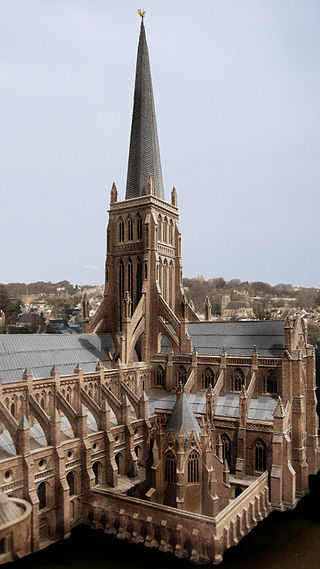
Newstead Abbey, in Nottinghamshire, England, was formerly an Augustinian priory. Converted to a domestic home following the Dissolution of the Monasteries, it is now best known as the ancestral home of Lord Byron.

Thurgarton is a small village in rural Nottinghamshire, England. The village is close to Southwell, and Newark-on-Trent and still within commuting distance to Nottingham. It is served by Thurgarton railway station. According to the 2001 census it had a population of 412, increasing to 440 at the 2011 census and marginally to 445 at the 2021 census.
This article contains a list of the known knights of the shire who represented Buckinghamshire in the Parliament of England and similar bodies of lesser status between 1290 and 1660. It also includes details of Parliaments from 1265 to which elected knights of the shires were summoned.

Fiskerton is a village and former civil parish, now in the parish of Fiskerton cum Morton, in the Newark and Sherwood district, in the county of Nottinghamshire, England. It is on the west bank of the River Trent about 3 miles southeast of Southwell. The waterfront is home to million-pound residential properties, previously residences of merchants and businessmen who commuted in the 1800s to nearby Nottingham by rail from Fiskerton Station. In 1881 the parish had a population of 283.

Shelford Priory is a former Augustinian Monastery located in the village of Shelford, Nottinghamshire, United Kingdom. The priory was founded by Ralph Haunselyn around 1160–80 and dissolved in 1536. Little remains of the original priory. Following dissolution it was granted to Michael Stanhope, and c.1600 Shelford Manor was constructed on the site. The manor was fortified and then partially destroyed during the English Civil War. The house was reconstructed c.1678, however, it was altered in the 18th and 19th centuries. It is now known as Shelford Manor and is a private residence.
The table of years in art is a tabular display of all years in art, for overview and quick navigation to any year.
This is a list of Sheriffs of Norfolk and Suffolk. The Sheriff is the oldest secular office under the Crown and is appointed annually by the Crown. He was originally the principal law enforcement officer in the county and presided at the Assizes and other important county meetings. After 1576 there was a separate Sheriff of Norfolk and Sheriff of Suffolk.

Ulverscroft Priory is a former hermitage and priory in Ulverscroft, Leicestershire.

Kirby Bellars Priory was a small priory of Canons Regular of Saint Augustine in Leicestershire, England. It is now the Church of England Parish Church of Saint Peter's serving the village of Kirby Bellars.

Felley Priory is a 16th century house with gardens located in the village of Felley, Nottinghamshire, UK. It is situated on the grounds of a former priory established by Augustinians in 1156 and dissolved in 1536. The gardens were started in 1974 by Maria Chaworth-Musters and opened to the public through the National Garden Scheme just two years later. Since Maria's passing in 2010, the gardens have been managed by her granddaughter and expert gardener, Michelle Upchurch. In 2021, the gardens were one of the four finalists in the public gardens category in NGS's The Nation's Favourite Gardens competition.

The Dean and Chapter of St Paul's Cathedral was the titular corporate body of St Paul's Cathedral in London up to the end of the twentieth century. It consisted of the dean and the canons, priests attached to the cathedral who were known as "prebendaries" because of the source of their income. The Dean and Chapter was made up of a large number of priests who would meet "in chapter", but such meetings were infrequent and the actual governance was done by the Administrative Chapter headed by the dean, made up of several senior "residentiary canons", who were also known as the "Dean and Canons of St Paul’s" or simply "The Chapter".
The bailo and captain of Negroponte was the representative of the Republic of Venice stationed at Chalcis (Negroponte) on the island of Euboea. The bailo played an important role as the mediator between, and de facto overlord of, the triarchs of Euboea, who had their common residence in Negroponte. The triarchies were created by the division of the island between three rulers (triarchs) after its conquest following the Fourth Crusade (1204).










